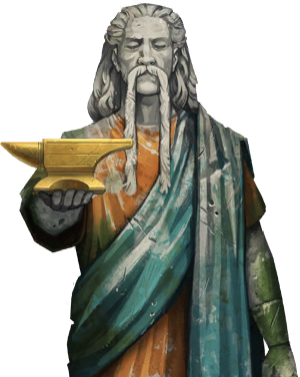| Book Information Facial Hair in Tamriel:Imperials |
|||
|---|---|---|---|
| Up | The Styles of Facial Hair in Tamriel | ||
| Prev. | Chapter 2: Bretons | Next | Chapter 4: Nords |
The styles of the ancient Imperials under the rule of Emperor Belharza were remarkably unique. Honoring the man-bull ruler, men grew large upturned mustaches that were waxed and styled into the shape of bull horns. While this style was quite popular according to numerous ancient tapestries, it was immediately outlawed after Alessian Order took power.
During this time, it became a sign of piety to be clean-shaven. Under the strict rulings of the Alessian Order, it was ordained by Marukh himself that men who strive to attain "Proper-Life" must remain beardless. Deviation from this teaching marked that person as a heretic and persecution would no doubt follow. This tradition remained for centuries and shaving became "the norm", even after the fall of the Alessian Order in 1E 2331 and throughout the rule of the Reman Dynasty. Indeed, a strong prejudice against facial hair formed, especially in the capital, where the social status of bearded individuals would be openly called into question.
Numerous styles of facial hair enjoyed an enormous resurgence across war-ravaged Cyrodiil during the chaotic Interregnum. In addition, with the worship of the Eight Divines firmly re-established, many of the faithful sought to emulate depictions of Akatosh, Arkay, Stendarr, and Julianos by wearing large beards. The "Zenithar Horseshoe" became a popular style among many traders and merchants in the late Second Era, which saw them grow long braided mustaches in honor of their patron deity.
Primate Articus, who became head of the Akatosh Chantry in the latter years of the Second Era, is famed as the first primate to wear a beard, and priests were expected to follow his example. Indeed, this was best illustrated by his popular decree that "Any man who appears in church with a clean-shaven face shall be excluded from the day's sermon, for that man is immodestly dressed." This trend continued into the Third Era and throughout the rule of Tiber Septim, where it became a sign of allegiance and respect among the nobility to keep a short, trimmed goatee beard as worn by the mighty emperor.
The pendulum swung once more as the age-old political and cultural rivalries between Colovians and Nibeneese resurfaced in the mid-Third Era. During this time Nibeney loyalism became rampant across the populace, and it became the custom for almost all Nibeneese men to be clean-shaven, supposedly to observe their ancient cultural roots. Being clean-shaven became a sign of Nibeneese pride and traditionalism.
Curiously, in the closing years of the Third Era facial hair disappeared from the Imperial province completely. Even Uriel Septim VII himself, who once proudly wore a full beard, became clean-shaven. The paradoxical disappearance of facial hair baffles historians to this day, however various theories are known to exist. These include a vampiric curse, an unseen disease that spread across the land, and even interference from the Daedric Prince Sheogorath, who himself has supposedly outlawed beards in his realm of Oblivion.
